Take a guess: What do writers, founders, sales representatives, support executives, recruiters, marketers, developers, and virtually every other category of professionals have in common?
Even though we specialize in different things, most of us spend a lot of time with our fingers dancing across a keyboard. Sometimes, in repeating the same sentences over and over.
Repetitively churning out the same message, email, report, update, reply…it can get to us.
It not just breeds frustration but also leaves us with less time to focus on tasks that actually matter and need us to put our thinking caps on.
Is there a way out? A way for us to enjoy the benefits of writing without dealing with the drawbacks of repetitive typing?
Yes. There are many tools and technologies to automate typing today, ranging from voice typing to using a text expander.
This guide will help you learn everything you need to know about using text expanders.
What is a text expander?
A text expander is a productivity tool that lets you eliminate repetitive typing tasks.
It saves you bucket loads of time by allowing you to insert phrases, sentences, and long blocks of text you use often, using simple keyboard shortcuts or abbreviations.
It’s a neat hack: You key in a short, oft-used phrase such as lmk and you’ll see it expand to let me know, in a jiffy. You can also save longer chunks of text. This can be something like o/address to fetch your address in an email or message.
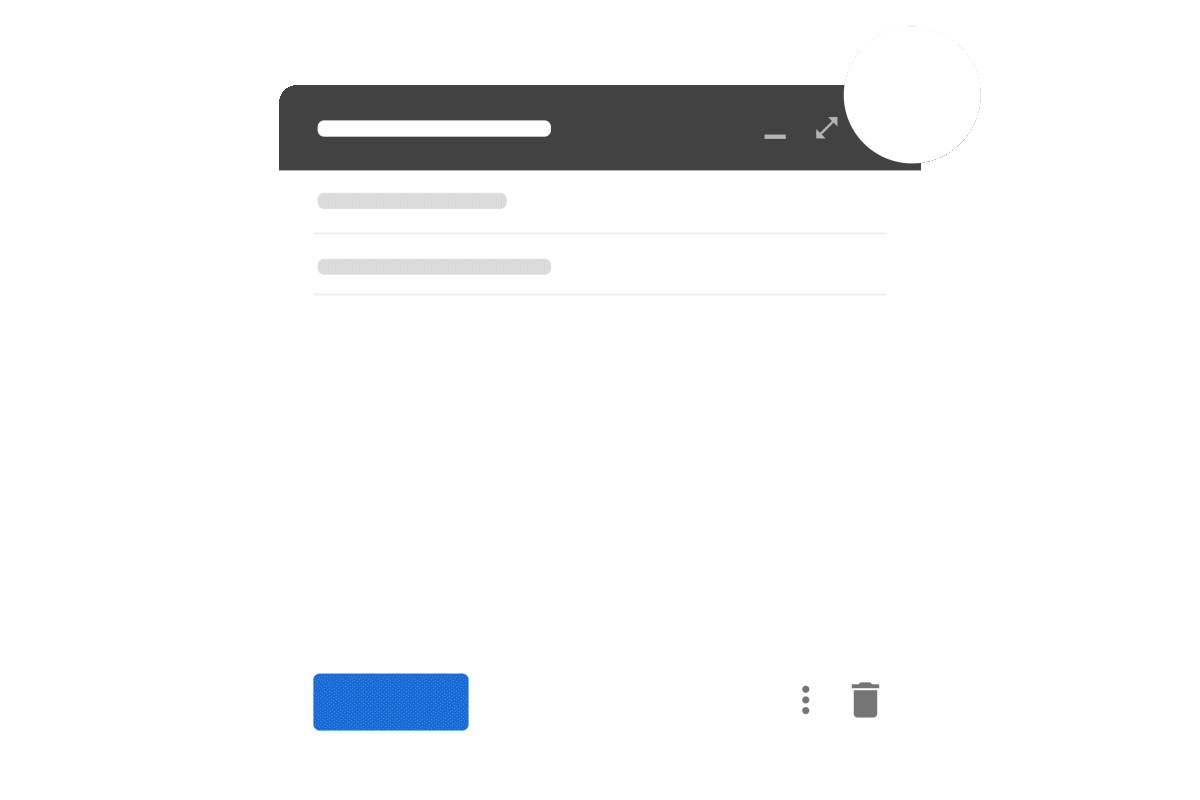
These frequently-used texts are often referred to as snippets. With snippets, you no longer have to type the whole thing from scratch and can let the text expander work its magic instead.
Of course, there can be no proper output without the right input. You’ll have to put in some effort and set your text expander up to perform these tricks. But think of it this way, you’ll be investing a few minutes of effort and saving yourself many, many hours of busywork in the future.
A pretty good deal, isn't it?
Why do I need a text expander?
I think everyone needs a text expander. We all deserve to make the best use of our limited time on the planet, don’t we?

On a more serious note, it is because a lion’s share of communication today takes place in writing.
Think of your average weekday. You get up and steal a glance at your WhatsApp or Twitter notifications. There’s almost always something awaiting your reply. As you get ready for work, your Slack buzzes with a new message notification and emails start pouring into your inbox. Answering all of these things will require you to type. And some of them will require you to type the exact same thing many times over.
Why waste precious time doing that daily?
It is worthwhile to delegate typing to an assistant so that you can focus on more meaningful work. A good text expander can be just that.
It can be particularly useful at work. Imagine typing out long chunks of repetitive text—customer support responses for hundreds of interactions; long pitch emails, outreach emails, and follow-up emails, product and company descriptions for landing pages of partner websites, rules and procedures for dozens of departments in a company…without a text expander.
I guess no one will ever get much done, except typing.
You could be looking at seven to eight hours of essentially unproductive activity every month. That’s the length of a full workday.
Don’t emails and messages that write themselves look extremely good, right about now?

What are the benefits of using a text expander?
Whether you wish to use a text expander individually or as part of a team or organization, there are many advantages you can glean from typing automation.
1. Higher personal and organizational productivity
A text expander reduces the effort involved in writing entire paragraphs to just a couple of keystrokes. Whether you type 20 words per minute or 120, text expanders will save you time, guaranteed. It frees you from the mundane, mind-numbing frustration that comes with the task.
Regardless of the function you perform in a company—sales, marketing, software development, HR, IT, product and project management—snippets can help skyrocket your productivity, helping you claim back hours every month. Higher personal productivity for everyone in the company translates into higher overall output for the organization.
2. Faster response times
Most of us deal with an ongoing deluge of emails and messages everyday. This is worse for people in customer-facing roles including marketing, sales, and customer service etc. They’re expected to reply to questions from prospects and solve issues for clients faster than the speed of lightning. Zendesk’s Customer Experience Trends Report 2020 found most customers on social media expect a business to respond in less than an hour.
Text expanders can help create templates and canned responses to improve response times and meet frustratingly high customer expectations.
3. Better quality and accuracy of information shared
Most businesses want to send out quality communication and maintain a good brand image at all times. In the absence of snippets, support and sales staff have to draft ad-hoc responses instantly and are more likely to make mistakes. Inconsistencies in information, grammatical errors, and typos sour the quality of the customer’s experience.
With snippets, you can also leverage the collective wisdom of everyone in the company instead of working in silos. Through shared snippets, your troubleshooting emails can be written by someone in IT, canned responses can come directly from the product team, and the company pitch can be consistent with the organization's shared vision.
4. Consistency in communication
All teams in the org can use a text expander to templatize routine tasks. Having templated emails, messages, and canned responses for static information, such as cold outreach follow-ups, FAQs, SOPs etc. maintains consistency in internal communication and external messaging across different departments and channels.
5. Scalability for businesses
One of the biggest benefits of using a text expander is that it gives a business the superpower of scale. With shared snippets, your team will always be able to hit the right notes in all the messaging. Company-wide snippets would get updated automatically whenever some tweaks are made, keeping everyone on the same page. When you free up valuable person-hours from busywork, you can redirect human resources to scaling faster.
Getting started with a text expander: Terms to know
By now, you understand the basics of how a text expander works.
Before we dive into the details of creating your first snippet, here are some terms that will help make the journey smoother.
- Shortcuts (or abbreviations): These are the trigger keywords that you can assign to blocks of text you type frequently (snippets). As soon as you type a shortcut, your text expander app will automatically convert it into the full-fledged block of text.
- Snippets: As described above, a snippet is a piece of text you can replace with a shortcut. It can also include images, screenshots, special characters, emojis, links, lines of code, and more. All you need to do is type it out once, designate a shortcut for it, save it in your text expander, and you’re all set.
- Macros: A macro is a piece of dynamic code or a built-in syntax that can automate repetitive functions within your snippet. You can use macros, for example, to pull in today’s date, fetch text from your clipboard, create custom keyboard shortcuts, etc.
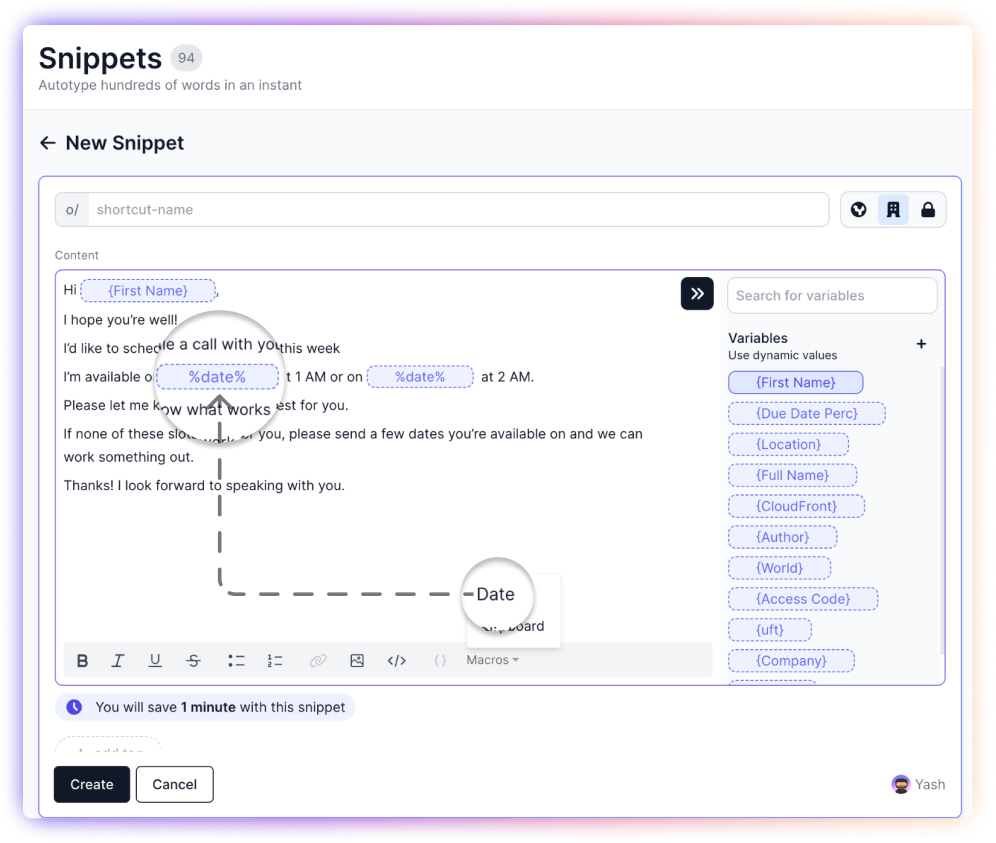
- Delimiter: A delimiter is a character that triggers your snippet into action. Once you type the delimiter, the text expander recognises it as a cue to transform your shortcut into its corresponding snippet. It’s also useful to avoid your snippets from triggering accidentally when you don’t want them to. Delimiters can be special characters or symbols or an extra letter appended to your shortcut.
Example: If o/intro is your shortcut for an email introduction snippet, then o/ is the delimiter. Likewise, if demo is your shortcut for the line “Book a demo on oslash.com/demo”, the extra d in front of the word demo acts as a delimiter ensuring you don’t expand the text automatically every time you type the innocuous word demo.
- Variables: A variable is a placeholder for a piece of text that can be automatically inserted into a document. For example, you might need to send 10 personalized cold emails a day to potential customers. In such a case, you can define <First Name> as a variable while creating a snippet for your email text. Then you can customize it to add first names of the respective prospects while keeping the rest of the email body unchanged for each prospect.
How does a text expander work?
Now that you know the elements that make a text expander work, let’s cover the essentials of text expander mastery.
Creating your first snippet
With a good text expander tool, your snippets can be a lot more than simple text. Snippets can include images, your favorite emojis, formatted text, dynamic variables, lines of code, and more. They can be used no matter where you work.
To create your first snippet, you’ll need to get a text expander. Check out our recommendations of the top 10 text expansion tools below for a quick comparison. Once you have the right app, all you need to do is to identify some common chunks of text you type often, add them to the app, set up a trigger shortcut, and save it to your snippet library.
Here are the kinds of snippets most text expanders support.
1. Simple, static text snippets
You can insert textbook replies on Slack for commonly asked questions.
o/ty can be “Thanks a ton for all the help. Really appreciate it.”
2. Snippets with URLs
.gif)
These days most of the information exchange happens via links because that has become the default place of work. Everything important is a URL, and fortunately, snippets can expand texts to include the destination links of the webpages you want.
o/product-intro can be used to say “Thank you for your interest in what we’re building. To know more about it, please check out our product demo and intro video.”
Snippets can include links to your calendar, to the product deck, or to a marketing video, so you can repurpose the content without making any tweaks at your end.
- Snippets with images
Text expanders bring with them endless customization options so you can format the text as well as include images where you need to.
Images and screenshots are especially helpful when responding to customer queries. They work well as you guide a user through a series of how-tos while answering FAQs.
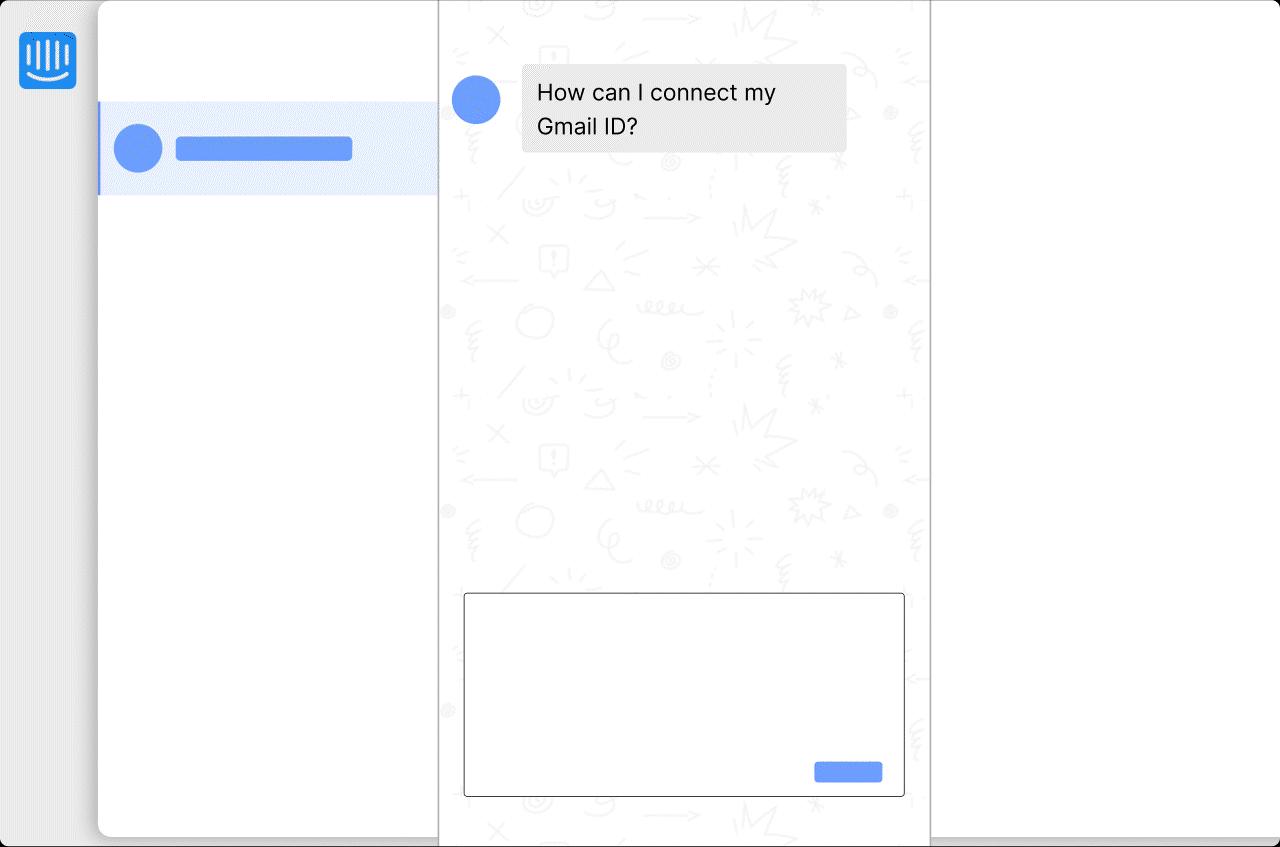
- Dynamic snippets with variables
To allow endless customization and personalization, snippets can be dynamic in nature.
You can simply insert variables wherever they are required while creating a snippet. While using the text expander, all you’d need to do is replace the variables with actual names of the people or their companies and you’ll be good to go.

Using macros
Simple and static text snippets help you type the exact same text without variation, every time you need to. Macros make your snippets customizable by automatically pulling in variables such as dates, times, copied clipboard text etc.
Text expanders usually support a number of macros including but not limited to:
- Dates and times
The date and time macros fetch the current date and time and add it to your snippet in a single keystroke, making it easier to update meeting dates, working hours, delivery timings etc. on the go.
- Clipboard text
The clipboard macro summons text you have copied, and pastes it into the desired spot within your snippet. Ditch right click to copy-paste and forget ctrl+c; ctrl+v forever.
- Cursor placement
The cursor macro places your cursor at the instructed point of your snippet after the expansion. It makes typing text between two brackets easier, for example, without needing to backtrack the cursor using the left arrow key.
- Tab key
The tab key macro is useful when you want to insert some text in one field (such as the recipient’s email address in your Outlook or Gmail) and then insert more text in the next field (such as cc and/or subject line) without lifting your mouse or pressing the tab key. It does the heavy lifting for you by automatically pressing tab once you’re done typing in each field. This can make drafting emails and filling forms a breeze.
Inserting snippets wherever you work
- Finding the right snippets
When you work with a few hundred snippets everyday, remembering the exact abbreviations can be a challenge. The good news? You don’t have to. Most text expanders come with powerful keyboard shortcuts to browse through your snippet library for the right one.
You can just start typing in a keyword into the search box and you’ll be shown a list of matching snippets to choose from. In addition to the shortcut names, the descriptions are indexed too, making your search smoother.
- Inserting the snippets via autocomplete (or point and click insertion)
Selected text expanders such as OSlash and TypeIt4Me save you from the hassle of memorizing cryptic abbreviations for your snippets. You can just start typing in the keyword and the autocomplete feature will show you a list of corresponding snippets to choose from. Point or keyboard navigate to the right snippet and click to insert it into your text editor seamlessly.
That’s it. That’s everything you should know before getting started with a text expander.
Now, let’s move on to some advanced use-cases and applications.
Text expander applications in everyday life—Use cases and examples
There are hundreds of creative applications of text expanders in everyday life. From acting as a highly personalized autocorrect app to helping you search frequented websites quickly, text expanders can do it all.
Wondering how to get started? Here are a few ideas for your first set of snippets.
1. Autocorrection
Do you, like one of my friends, often get confused between wierd and weird? Or spell embarrassment with a single r or a single s? English spelling is tricky, to say the least. Typos and misspelled words in business communications can hurt your credibility and brand image, especially if a grammar purist decides to make them go viral.
A good text expander can save you from your 15 minutes of infamy. Add common typos and words you frequently misspell to your snippet library. The next time you make a mistake, your text expander can act as a spell-checker and automatically replace them with the correct version.
You can also consider using text expanders to correct proper names (replacing sandra with Sandra for addressing a colleague, for example) and to add accent marks to foreign words used in English (such as replacing cafe with café).
Pro tip: While it’s a great idea to use a delimiter for most shortcuts, autocorrections work best without one. Your misspelling should be corrected immediately as you type without a special trigger.
2. Email templates
If your job involves sending the same emails to a bunch of different people (with or without customization) every day or answering emails with the same predefined responses, you need a text expander, yesterday.
Typing the same outreach and networking emails, cold sales pitches, feedback requests, recruitment emails, pitch emails to investors etc. again and again is a surefire way to tank your productivity. It can be a huge time sink, especially for people who work with multiple clients—sales executives, support teams, recruitment agents, and others. Even copy-pasting the same text keeps you wrapped up in busywork that accomplishes nothing.
The solution? Email templates that you can reuse at the click of a button or with a couple of keystrokes. With a text expander, you can draft a template for each email that you send more than once and save it as a snippet. Then, you can insert it within seconds, personalize by adding dynamic variables, and get more work done within the same time.
3. Canned responses
The cousin of email templates, canned responses refer to quick, standard, and predetermined replies to a routine question. They’re helpful for companies to answer a high volume of FAQs that require prompt and accurate responses.
For example, a customer support agent may only need to type o/feedback to thank a customer for providing feedback in the chat. The shortcut can expand to a full fledged response:
Thank you so much for your kind words. Making our customers happy is our topmost priority. And we’re immensely glad we could do that. Sending your wishes (and some much-deserved kudos) to our team right away!”
Companies can use text expanders to create a repository of canned responses and let everyone invoke them within milliseconds.
Recommended reading:
What is a canned response? - The ultimate guide with examples
4. Frequent URLs
With an explosion of apps on the browser, every resource and piece of work — from a Zoom meeting to your favorite show on Netflix— lives in a link.
In these times, looking for a specific URL is like searching for a needle in a haystack. To avoid digging through unending email threads and bookmarks for links and open them faster, you can use text expansion.
Example: You can create a shortcut to this article: o/text-expanders and save it as a snippet. The next time you type o/text-expanders in your browser, it will expand to the original URL and bring you straight to this guide!
5. Code snippets
Developers can save a lot of time by saving frequently-used pieces of code in a text expander. Rather than manually typing the same code each time in a new environment, for example, they can summon the snippet in a couple of keystrokes and ship code way faster.
6. Identification information
Can you recall how many times you’ve had to type and share random bits of personal information listed below in the last one year?
▪ Your phone number
▪ Your email address and signature
▪ Your home or office address
▪ Your company’s details
▪ Your bank account details
Sure, it will hardly take you 20 seconds to type all of this from scratch. But if you’ve done that hundreds of times over the last year, you’ve spent minutes, if not hours of productive time just messing with the letters on your keyboard. A text expander can fill these out automatically for you wherever you need, including registration forms, checkout pages, emails, and text messages.
7. Phrases and shorthand text
Type ty and send thank you so much for your time. Type omw and send on my way. Type lmk and send let me know what you think. If there are phrases or shorthand you use often in a formal setting, use a text expander to replace them with the ‘proper’ version and reclaim the time spent typing. Every second counts.
8. Booking/calendar links
If your work involves getting into a lot of calls and meetings with people, chances are you use booking or scheduling apps such as Calendly or Savvycal to keep track of them. Since you need to share your calendar URL with people time and time again, you can create a snippet such as o/cal and have it expand into the full URL effortlessly, without needing to copy-paste it.
9. UTM links
This one’s a godsend for marketers! Marketers use UTM links to track promotional URLs and attribute the traffic and conversions on them to its right medium, source, campaign, and creative etc.
UTM links are often long, messy, and unsightly.
There are two handy ways of using a text expander to make them less of a bother.
a. Create UTM snippets that you can add to a URL
Suppose you have a blog post URL: https://www.oslash.com/blog/how-to-boost-productivity-by-using-text-expanders
And you want to share it on Facebook by adding the UTM parameter: ?utm_medium=blog&utm_campaign=textexpander&utm_source=facebook
You can save the utm parameter as a snippet called o/utm
Now, you can simply type
https://www.oslash.com/blog/how-to-boost-productivity-by-using-text-expanders/o/utm and it will automatically add the tracking to your link as
https://www.oslash.com/blog/how-to-boost-productivity-by-using-text-expanders?utm_medium = blog&utm_campaign = textexpander&utm_source = facebook
b. Create a dynamic snippet to customize UTM parameters
You can create a dynamic snippet to build different UTM parameters for different posts as building them via the Google URL builder can be tedious.
Just follow the syntax in the image below and input the right variables in your target URL, source, medium, and campaign to get going.

10. Markdown text
With markdown, your fingers never have to leave the keyboard even if you wish to format your typed text. You can make your text bold or italicized, for example, add a hyperlink, insert a numbered or bulleted list, embed a video etc. all using just a keyboard. With a text expander, you can store common markdown syntaxes as snippets and make them even faster to access.
Example: Markdown *x* will make x italicized. You can store a snippet * that expands to *[cursor]* in your text expansion app to create a new piece of italicized text.
11. Obscure symbols, special characters, emojis, hashtag groups etc.
Isn’t typing obscure symbols such as © or emojis such as 🎯a pain in the neck when you’re trying to work fast? You either have to remember the exact keyboard shortcut for activating the symbol or Google and copy-paste it. It slows you down and breaks the flow of your writing.
The solution? Create snippets for your frequently used symbols, special characters, emojis, and even hashtag groups for one-touch access.
Here’s an (extreme) example from our own workspace: o/mandarin-characters

But you’re welcome to stick to basics like o/euro for € or o/grin for 😄
12. Searching sites faster
Did you know if you want Google to fetch search results from a particular site, say oslash.com, you can use the syntax site:oslash.com and narrow the results to your liking? You can use a text expander to avoid typing the syntax repeatedly while digging through a site.
At Apple, engineers search the Support site for help docs so often that they’ve made a snippet called kbs to fetch the syntax into the address bar in a flash.
13. Scripts to automate workflows
If you want to go a step further and overcome the limitations of a text expander to automate everything (such as breezing through signup forms, automatically fetching the recipient’s name from an email address etc.), many text expansion apps support programming languages such as JavaScript, AppleScript, and shell scripts to do so. You can use them to build simple workflows for getting everyday tasks done a lot more quickly.
Text expander use cases for businesses
Text expanders can help not just individuals but also teams and entire organizations take charge of their productivity.
Here’s how different teams in a company can rely on snippets to save time and get their job done, blazingly fast.
Text expander for Sales teams
Outreach: You can templatize your cold sales outreach emails and pitches to prospective customers and add fields such as {first-name} or {last-name} for personalization. You can even create a snippet with a meeting link/contact details/pre-recorded demo video that goes out to prospects as soon as they sign up on your website or express interest in being contacted. This outreach pitch can be carefully crafted and based on the development cycle of the product. It can be updated regularly for the entire team.
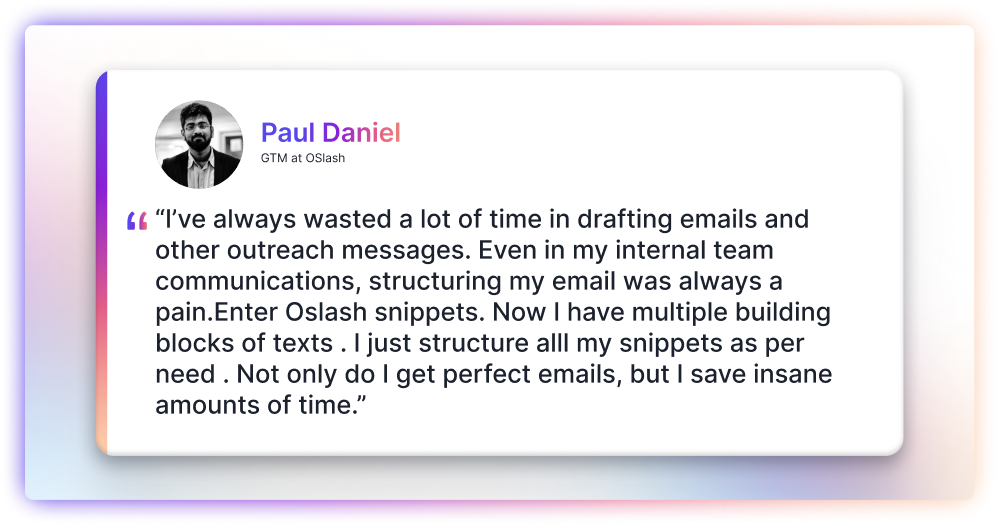
Queries redressal: If your product is technical in nature, then your pre-sales and post-sales time will be inundated with multiple questions about it. To not waste much time and respond to potential users as soon as possible, using a text expander is a brilliant idea.
With text expanders that work for the entire team, you can ask the IT team, founders, support engineers, or product managers to craft the right response to technical questions and use them easily.
Text expander for Customer Service teams
Canned responses: Most live support chats follow a prescribed series of steps broadly including greeting a customer, enquiring about their problem, providing more information or offering an immediate solution, and ending the chat. While it is easier to repeat the same thing verbally to more than one customer, typing takes a lot more time. This is avoidable because each of these steps can be templated using a text expander. As a team, you can significantly reduce the time it takes you to reply, thereby keeping customers happy with immediate solutions. This helps nurture leads and hasten the road to conversion.
Recommended reading:Complete guide to canned responses
Text expander for Marketing teams
Company intro: As a marketer, you want to ensure that every time you communicate what your company does, you use the same blurb. There is nothing more important than maintaining consistency in communication and messaging. Marketers can easily use text expanders to create a shortcut such as o/company-intro to insert the message wherever required.
Social media: Twitter, Facebook, LinkedIn, Instagram, TikTok—they’re not just places to entertain ourselves anymore. They’re also how your customers find you and get in touch with you to ask questions, raise issues, and if you’re lucky, shower compliments. To get more compliments than criticism, make sure to use text expanders to insert responses for the most common questions asked on your social media channels and for dealing with the trolling that is sometimes part of the job.
Recommended reading:
Guide to using canned responses for social media support
Text expander for Human Resource teams
Hiring: From inviting candidates to apply & scheduling interview calls to sending out rejection or acceptance emails, a human resource professional sends out multiple similar emails every day. Instead of allowing crafting emails to take multiple hours from the workday, it would be so much easier to automate the emails with the use of text expander. Craft each type of email and assign them shortcuts that can be inserted in the mail copy within seconds.
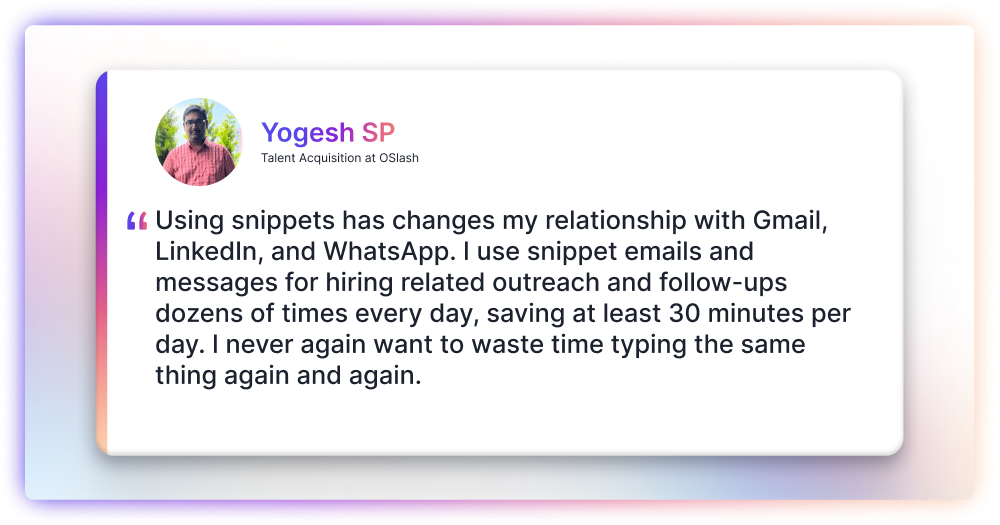
Onboarding: Poor onboarding can leave a new candidate disengaged with low confidence, disassociated with the long-term company vision, and culture and at an increased risk of jumping ship if confronted with a better offer elsewhere. On the other hand, companies that implement a formal onboarding program could see 50% greater employee retention among new recruits and 62% greater productivity within the same group. While onboarding can be a tiresome task, it can be made super simple to implement across various teams with a text expander. Simply create shortcuts for onboarding candidates in different teams and create a flow such as
o/onboarding-design-1, followed by o/onboarding-design-2 and o/onboarding-design-3 to send out emails instantly.
Outreach: Good candidates are not easy to come by. Talent recruitment teams have to continually send out the perfect company pitch to multiple personas at once to clock in sufficient leads. Wouldn’t it be awesome to type a word and have the pitch email or LinkedIn message ready to go?
Recommended reading:
Guide to writing the perfect cold recruitment email (with 7 high-converting templates)
Text expander for Software Development/Engineering teams
Code: Engineering teams can code faster and with fewer errors in multiple environments by using a text expander. By saving commonly used pieces of code as snippets, developers can save the precious minutes spent typing the same lines over and over. A text expander is one of the most effective tools to skyrocket developer productivity.
Internal project updates: Internal project updates by the whole team, in weekly standups, for example, can be standardized by creating fillable templates. Instead of drafting tedious updates from scratch, all engineering managers have to do is input the variables in a standard form, saving everyone time that is better devoted to actual development.
Macros and scripts: Some text expanders also allow developers to test or demo software features by automatically filling in text fields using simple shortcuts and tab macros. With the help of scripts in snippets, you can also automate routine workflows such as generating random email addresses, converting long URLs into short links, fetching the contents of a Jira or Linear ticket with a shortcut etc.
Text expander for IT Support teams
FAQs: IT Support teams deal with a flood of questions and support enquiries on an everyday basis. Text expanders can help by sending answers to FAQs such as reboot instructions, password reset procedures, data security policies etc. in just a few keystrokes. It is also helpful that the FAQs are drafted and kept updated by experts instead of an agent who might be unaware of the technicalities.
Text expander for Legal teams
Legal terms: Legal terms can be true tongue-twisters. Corporate legal teams deal with a ton of paperwork that requires repetitive use of legal jargon. This can be a mouthful to speak and a handful to type. Set legal teams up for success by creating shortcuts for long, complex words and phrases such as o/jur > jurisdiction, o/arb > arbitration, o/ci > certificate of incorporation etc.
Contracts/T&Cs: Summon (pun intended) common legal clauses, terms and conditions , boilerplate language, and document templates within seconds by saving corresponding snippets into your text expander and cut down on annoying repetition every time a legal matter pops up.
The obvious conclusion?
Text expanders can make life so much easier and stress-free at work! And if you’re convinced to get your hands on one, we’ve got you covered with these top recommendations.
Top 10 text expander tools to try out in 2023
There are many text expansion apps to choose from, depending on your needs and budget.
If you’re using a Mac, built-in Text Replacement can be a good place to start. It’s not the most advanced of text expanders but can help you figure out the basics for free before you invest in a smarter and more comprehensive tool.
Recommended reading:
Why Mac’s built-in Text Replacement isn't a perfect solution for text expansion?
Here is a handy list of popular and top-rated advanced text expanders people trust.
1. OSlash
2. Text Blaze
3. Magical
4. Phrase Express
5. aText
6. Alfred
7. Espanso
8. FastKeys
9. TypeIt4Me
We’ve tried them out and summarized our findings so that you can save some more time on your search for the best text expander tool. Read on!
1. OSlash

Best for: Replacing long URLs and snippets with custom keyboard shortcuts
If you’re looking for the best text expander on the market, beware! OSlash isn’t it. It is, however, the best productivity suite in the market. We may be biased but you can probably see why.
You can use OSlash to auto-type text using shortcuts everywhere you work. But that’s not all.
None of the other apps on our list will offer you the powers of text expansion together with a link management solution that also doubles (or triples) up as a knowledge management platform for your company.
No wonder it can save you up to 30 hours every month!
Top features
- Create shortcuts to access and share your frequent web pages, apps, documents, and URLs, in less than a second
- Create and format snippets the way you want with a rich text editor
- Insert variables to craft highly dynamic, personalized messages
- Create snippets with access control: for yourself, your team, or your whole org
- Highlight anything on the web and convert it into a snippet
- Gain one-touch access to your shortcuts, tabs, and activity
Recommended reading:
Embrace fast messaging and better user interactions with OSlash
Available for
Chrome, Mozilla Firefox, Safari, Edge, Brave (extensions), macOS, iOS (coming soon)
Pricing options (billed annually)
- Pro: $3 per user per month
- Expert: $6 per user per month; free 15-day trial available
- Enterprise: Custom
2. TextExpander

Best for: Sharing snippets across devices and customizing automation scripts
An incumbent, TextExpander helps you save time by allowing you to create and use your text snippets across a variety of devices. It is best suited for teams of all sizes or freelancers who are tired of sending the same pitches and follow-ups every day.
Top features
- Access your snippets on all your devices
- Share snippet groups with your circle
- Enjoy unlimited usage for a single user
- Get free app updates on all plans
- Auto-subscribe users to snippets and get snippet statistics
Available for
Chrome, macOS, Windows, and iOS.
Pricing options (billed annually)
- Individual: $3.33 per user per month
- Business: $8.33 per user per month
- Growth: $10.83 per user per month
- Enterprise: Custom
(30-day free trial of the two lower tiers is available)
3. Text Blaze

Best for: Using snippets across Chrome and Chromium-based browsers and natively on Windows
Text Blaze lets you create, save, and insert text snippets and templates anywhere using keyboard shortcuts of your choice. It's a blazingly fast app that works as a Chrome Extension and a native app for Windows.
Top features
- Create forms with input fields for inserting custom data into snippets
- Use dynamic formulas to calculate values instantly
- Simulate clicks or key presses to automate repeatable workflows
- Create shared snippets with colleagues that get updated automatically when edits are made, to maintain consistency
- Active community forum to discuss the most productive ways to use Text Blaze and profit from its key functions and features.
Available for
Chrome/Chromium, Edge (extensions)
Pricing options (billed annually)
- Basic: Free
- Pro: $2.99 per user per month
- Business: $6.99 per user per month
- Enterprise: Custom
4. Magical

Best for: Auto-filling documents without copy-pasting between tabs
Formerly known as Auto Text Expander for Google, Magical is a free text expander that claims to “Make tasks disappear. Like magic.”
Its USP? The plug and play user experience. Magical does away with integrations and APIs to keep things extremely simple for everyone.
Top features
- Populate sheets, messages, and forms without switching between tabs and copy-pasting data
- Expand shortcuts into full-fledged texts across over 10,000 apps on the web
- Search shortcuts seamlessly with tags or type // to activate a dropdown for shortcut discovery
- Create and lookup your shortcuts anywhere on the web with the Magical Panel
- Get curated shortcut templates with magic packs
- Create unlimited shortcuts with unlimited character count per shortcut
Available for
Chrome (extension)
Pricing options
Available for free for now
5. Phrase Express
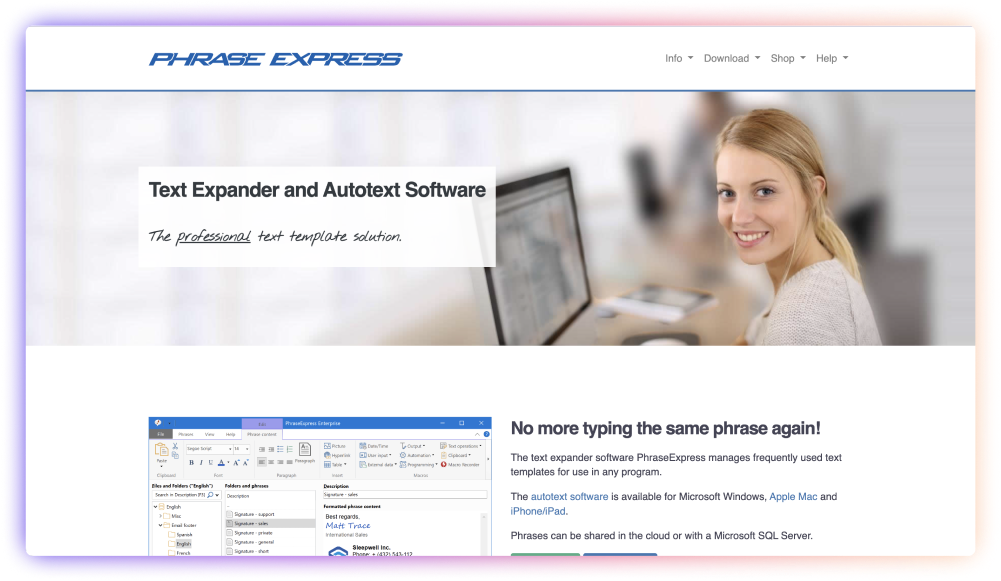
Best for: Working with and organizing multi-language snippets
PhraseExpress is one of the pricier text expanders. And for good reason.
It automates your repetitive tasks using powerful macros. Its Macro Recorder “records your actions like a tape recorder for infinite playback.” And it comes with a document generator that can create an entire document from scratch using a custom selection of your templates.
Top features
- Store snippets locally and share them with others over the cloud or using network-shared folders between multiple Windows and Mac computers
- Organize snippets in a tree structure rather than flat groups
- Flexibility to assign the same shortcut for multiple snippets and choose the best fit from a smart dropdown menu
- Autocomplete snippets instead of memorizing cryptic abbreviations
- Snippets that adapt to the gender of the recipient
- Multi-language support lets you translate snippets into other languages. The same phrase library can be switched to another language instantly.
Available for
Windows, macOS, iOS
Pricing options
(All plans provide a lifetime license with one year of free updates & upgrades. Post that you have to pay for maintenance renewal.)
Free: For personal use
3 pricing plans for commercial use (prices without taxes as of Sep 2022):
- Standard: $81.31
- Professional: $120.96
- Enterprise: $203.34
6. aText
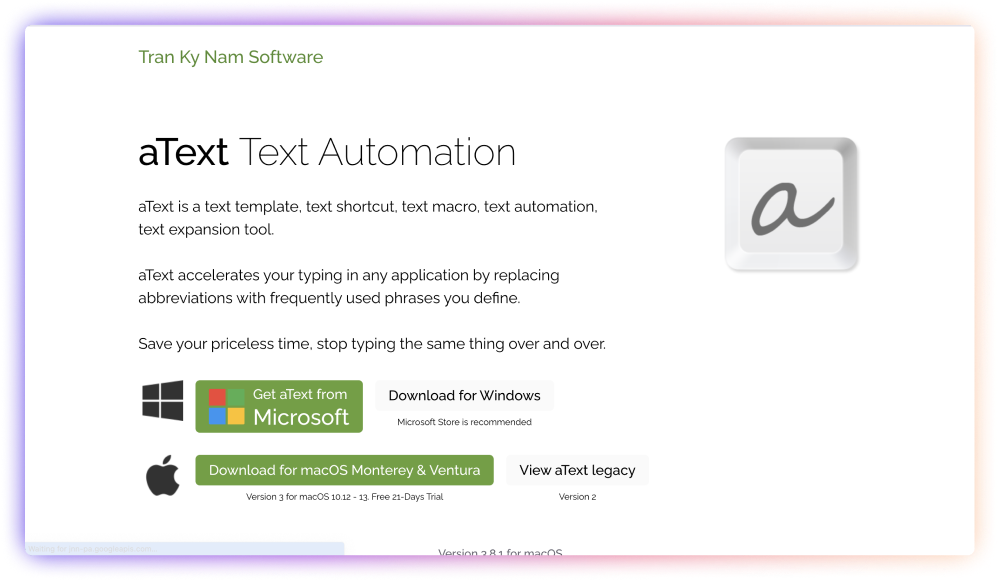
Best for: Beginners looking for a cost-effective text expander
aText seeks to accelerate your typing, like other text expanders, by replacing frequently used phrases you define with abbreviations/shortcuts. You can format your snippets to include images and multimedia in the rich-text editor. There are also groups and subgroups to organize your shortcuts effectively.
Top features
- Import data from TextExpander, TypeIt4Me, SpellCatcherX, Automaton, CSV file etc.
- Embed clipboard content within snippet, embed snippet within another, send use editable fields in snippet
- Reposition the cursor in the expanded snippet
- Auto-Correction: Automatically capitalize new sentences, correct double capitals
- Built-in snippet groups for misspelling correcting, HTML and JavaScript coding
Available for
Windows, macOS
Pricing options
- Basic: Free (Windows); $4.99 for a lifetime license (macOS) with a 21-day trial
- Premium: $29.99 for a lifetime license
7. Alfred
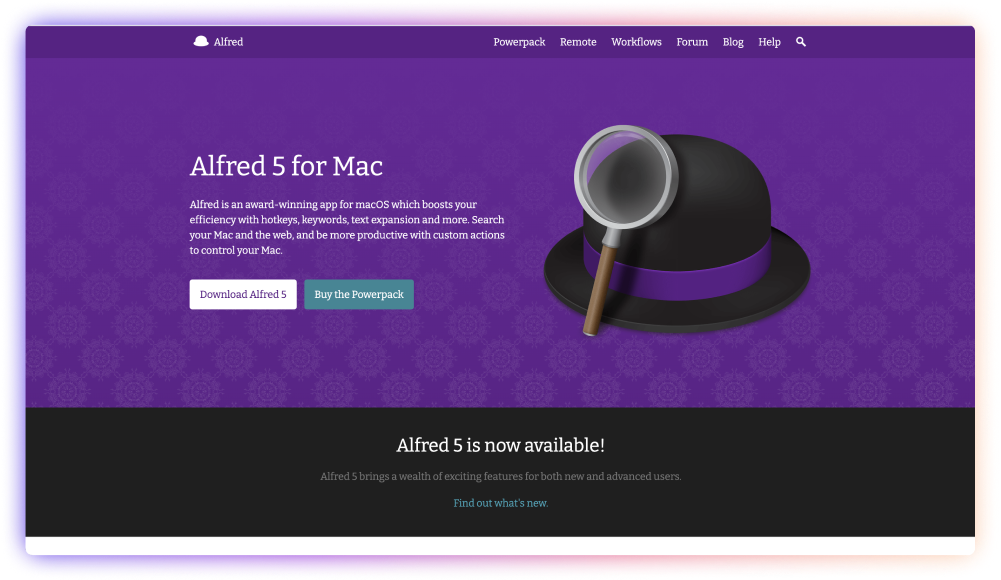
Best for: Lightweight text expansion plus custom Mac automation
Alfred is an automation app for macOS designed to maximize your productivity with custom actions, hotkeys, keywords, text expansion and more. While the app is free to download, you’ll need to buy the Powerpack for using the text expander, accessing clipboard history, and automating workflows.
Top features:
- Search for the right snippet seamlessly with Snippets Viewer
- Use snippets to trigger custom workflows
- Search the web, find local apps & files, access clipboard history, and execute system commands quickly with custom hotkeys
Pricing options (Alfred 5 Powerpack):
- Single License: £34
- Mega Supporter: £59 (includes free lifetime upgrades)
8. Espanso
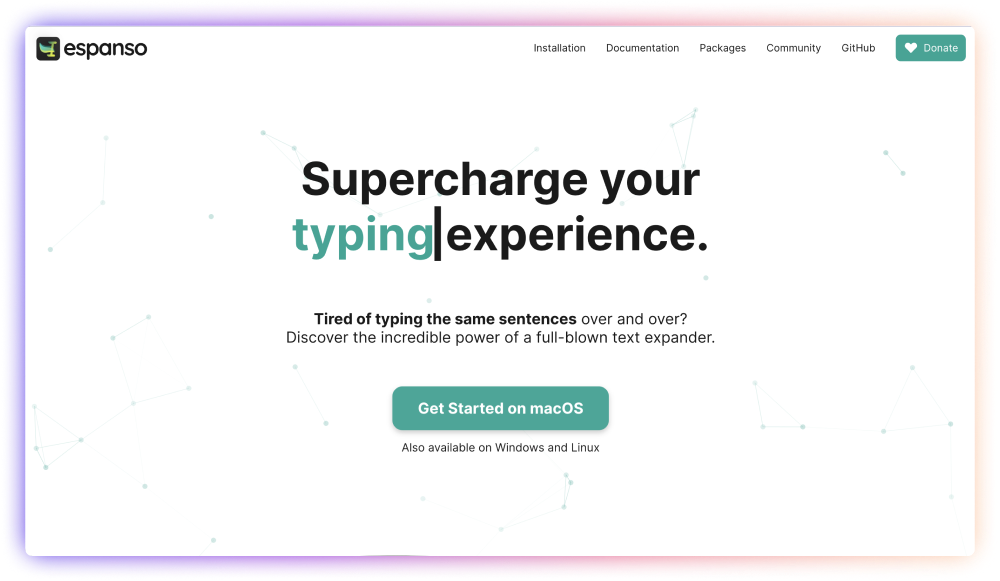
Best for: Free and open-source text expansion with “endless extensibility”
Espanso is a free and open-source text expander tool that offers all the basic functionalities you expect from an autotext app. The tool uses a code-based method to create shortcuts which might take some getting used to.
Top features
- Custom forms to include dynamic inputs such as dates
- Ability to run scripts from a snippet
- “Endless extensibility” via Packages: Packages are collections of snippets put together by the Espanso community for writing non-standard text including language accents, mathematical symbols, scientific notations, emojis, and more.
- Cross-platform support for Mac, Windows, and Linux: You only need one main config file to sync the same shortcuts everywhere.
Available for
Windows, macOS, Linux
Pricing options
Available for free for now
9. FastKeys

Best for: Automating your Windows machine
FastKeys is more than your ordinary text expander. It is an all-in-one automation tool for Windows that boasts over 500 ready-to-use commands to automate your everyday repetitive actions.
Top features
- Build a custom start menu to fire up chosen apps on your computer upon login
- Configure custom keyboard shortcuts to open sites, run powerful scripts, and start programs in a couple of keystrokes
- Expand abbreviations for frequently used text to save hours spent typing
- Use mouse gestures to execute actions from a vast library automatically
- Use the macro recorder to record keystrokes and mouse actions and teach the computer to perform everyday tasks on its own
Pricing options
Lifetime licenses available as follows
- Personal: $19 (use on up to 3 computers)
- Professional: $29 (price per computer - volume discounts available)
- Enterprise: Custom (Volume discounts available)
10. TypeIt4Me
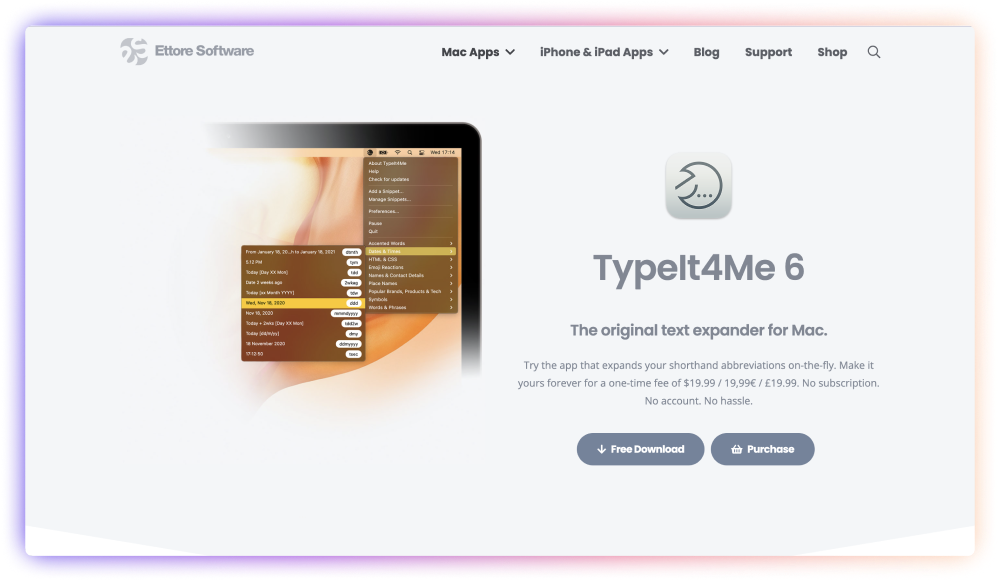
Best for: Point-and-click insertion of snippets
The first ever text expander developed for Mac, TypeIt4Me has been around for over three decades now.
The upside? It works natively on all Mac apps that require typing.
The downside? It works only on Mac and iOS.
P.S. You need the TypeIt4Me Touch notepad app for using TypeIt4Me on your iPhone and iPad.
Top features
- Create a snippet from selected text
- Instantly fix spelling mistakes by adding commonly misspelled words to your abbreviations list
- Autocue placeholders, aka “fill-in fields” for inserting variable inputs into snippets
- Define hot keys for quick access to TypeIt4Me functions
- Restrict snippets and snippet sets to specific apps
- Ditch memorizing abbreviations and rely on point-and-click insertion of snippets from the menu bar
Available for
macOS and iOS
Pricing options
- Lifetime license available for $19.99 / 19,99€ / £19.99 (30-day trial available)
Best practices to speed up typing and skyrocket productivity using a text expander
When it comes to topping productivity charts, just having the right productivity tools at your disposal isn’t enough. You might have access to the best text expander ever built and yet fail to make the best use of it.
Here are some foolproof tips on how to type faster (and error-free) using a text expander tool.
- Keep your shortcuts brief and simple
- Ditch shortcuts with common keywords
- Designate delimiters to avoid accidental snippet expansion
- Have a system and don’t overcomplicate it
- Review and update your snippets regularly
Let’s explore them in depth.
1. Keep your shortcuts brief and simple
The sole purpose of using a text expander? Typing at a higher speed. If the abbreviations for your snippets are long, complex, and hard to recall, you will end up wasting time on them instead of using them to save time. Take charge of your productivity by using brief, simple, unique, and memorable shortcuts for your snippets.
2. Ditch shortcuts with common keywords
If you’ve a snippet set to trigger with a word you use frequently otherwise too, there are high chances of text replacement being triggered without you intending to.
For example, if you’ve saved the shortcut to your email signature snippet as your name (say, John), every time you type “Hi, I am John'' in a message, it will expand to Hi, I am John Mercer john.mercer@acme.com +1 (273) 459-8065. I’m guessing you don’t want that to happen in every new conversation you have. Try replacing the shortcut with something like /john or ajohn instead.
3. Designate delimiters to avoid accidental snippet expansion
This brings to our next tip: Use delimiters to define your shortcuts. As you saw in the above example, it’s easy to accidentally expand your text even when you don’t want to, if you use a common word as a shortcut. The ‘/’ and ‘a’ in the above example aren’t typical characters you’ll use while typing. They act as delimiters and prevent accidental text expansion.
Pro tip: Letters are better than special characters when choosing a prefix, especially if you do a lot of text replacement on your phone or tablet. Using a letter is more efficient as a prefix because you’ll not need to switch the keyboard to trigger the snippet.
4. Have a system and don’t overcomplicate it
Like with most productivity methods, having a personalized system to use a text expander will help you maximize your efficiency gains. There is no one size fits all for text expander snippets and naming conventions. Some may want to prefix their shortcuts with the same delimiter, some may want to group related snippets together for faster access, while some others might use unusual capitalization or remove vowels from shortcut names to set them apart.
5. Review and update your snippets regularly
The most efficient way to use a text expander? Making sure that your snippets are relevant and up to date. It’s essential to weed out snippets you no longer use, update the content where it is needed, and restore a sense of order to your snippet library periodically. A review of your snippets every 6-12 months can easily help you fix these issues.
There you’ve it. If you’ve made it this far, you’re already much ahead on your way to being a pro user of text expanders.
But you probably have one last question in mind.
Is it safe to use a text expander?
You’re creating snippets that will often contain sensitive personal information and you may have concerns about your keystrokes being logged by the app and accessed by a third party.
Worry not, for most text expanders are built to put the privacy and security of their users at the center of everything. They are usually not keyloggers; they neither store nor share your keystrokes for the long term. Such apps hold only the bare minimum data in your system memory to function and erase the logs when you quit the application.
That said, make sure you don’t use text expansion tools to auto-fill data such as credit card details, passwords to banking sites, confidential business data such as client email addresses etc.
Why? Because anyone with access to your machine can potentially see it, rendering it unsafe. It’s always better to use vaults such as 1Password for handling these bits of information securely.
Tips for getting started with text expanders such as OSlash
Ready to skyrocket your productivity? Here are tips for getting started with OSlash’s text expansion software.
Start with basic snippets. You can create a snippet for your most-frequently used responses to your team members. This will help you get used to the platform.
Next, start with creating snippets for your product’s most frequently asked questions. You can include screenshots explaining the steps to make them more helpful. Make sure these snippets are available to the support team on priority to reduce redressal times.
You can then proceed to create a snippet (in collaboration with the executive team in the company) deep-diving into what your product does. You will be surprised to hear multiple versions of how your company is pitched to others online. Having a handy blurb will keep the message consistent everywhere.
Make a habit of turning content you repeatedly type into snippets. For example, you can set a rule that, whenever you type something in your email or elsewhere twice, you’ll turn it into a snippet.
Try out the best text expander in the market for free
Convinced that you want to give text expanders a spin to free up more time in your workday? Give the best text expander - OSlash - a try and thank us later.
Using a text expander like OSlash can have a truly amazing effect on your work. You will be able to save close to 30 hours a month by automating your most frequently used snippets, formatting them to look beautiful, and inserting variables in highly personalized messages.
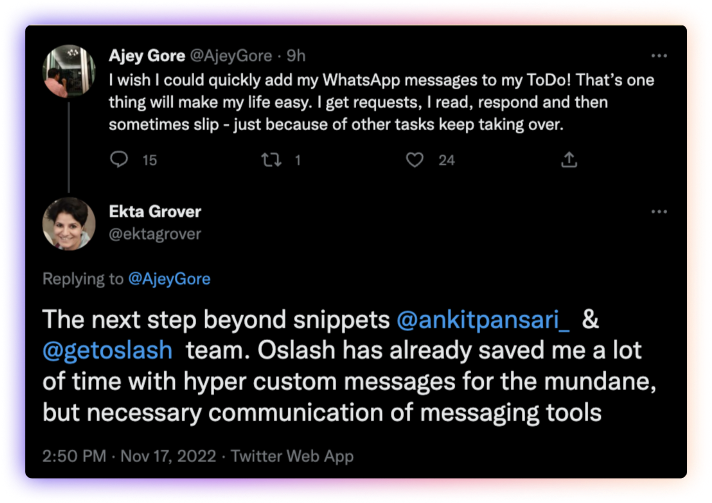
It is super easy to use and share with the entire team. You will be able to create snippets for your team, your workplace, or just for yourself. Additionally, you can also highlight anything on the web, right-click and convert it into a snippet with OSlash.
The best part? OSlash also helps you transform your most frequented pages/links into simple shortcuts such as o/daily-standup or o/q1-priorities. So that you can find, access, and share information blazingly fast. It is the best tool to streamline your workflows and be more productive.

.webp)
